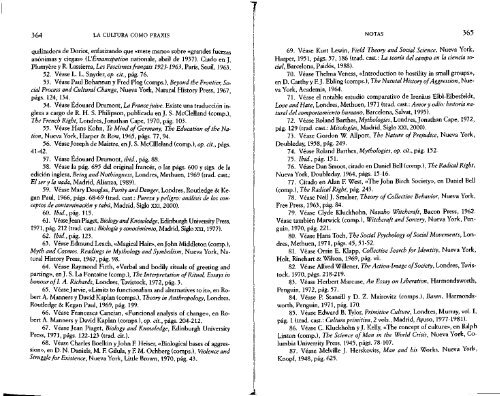Zygmunt Bauman La cultura como praxis
Zygmunt Bauman La cultura como praxis
Zygmunt Bauman La cultura como praxis
Create successful ePaper yourself
Turn your PDF publications into a flip-book with our unique Google optimized e-Paper software.
364 LA CULTURA COMO PRAXIS<br />
quilizadora de Doriot, enfatizando que «mete mano» sobre «grandes fuerzas<br />
anónimas y ciegas» (L'Émancipation nationale, abril de 1937). Ciado en J.<br />
Plumyére y R. <strong>La</strong>ssierra, Les Fascismes francais 1923-1963, París, Seuil, 1963.<br />
52. Véase L. L. Snyder, op. rít., pág. 76.<br />
53. Véase Paul Bohannan y Fred Plog (comps.), Peyona the Frontier, Social<br />
Process and Cultural Change, Nueva York, Natural History Press, 1967,<br />
págs. 124, 134.<br />
54. Véase Édouard Drumont, <strong>La</strong> Francejuive. Existe una traducción inglesa<br />
a cargo de R. H. S. Philipson, publicada en J. S. McClelland (comp.),<br />
The French Right, Londres, Jonathan Cape, 1970, pág. 103.<br />
55. Véase Hans Kohn, Te Mind ofGermany, The Education of the Nation,<br />
Nueva York, Harper & Row, 1965, págs. 77, 94.<br />
56. Véase Joseph de Maistre, en J. S. McCllleland (comp.), op. rít., págs.<br />
41-42.<br />
57. Véase Édouard Drumont, ibid., pág. 88.<br />
58. Véase la pág. 695 del original francés, o las págs. 600 y sigs. de la<br />
edición inglesa, Being andNothingness, Londres, Methuen, 1969 (trad. cast.:<br />
El ser y la nada, Madrid, Alianza, 1989).<br />
59. Véase Mary Douglas, Puríty andDanger, Londres, Routledge & Kegan<br />
Paul, 1966, págs. 68-69 (trad. cast.: Pureza y peligro: análisis de los conceptos<br />
de contaminación y tabú, Madrid, Siglo XXI, 2000).<br />
60. Ibid.,pág. 115.<br />
61. VéaseJean Piaget, Biology andKnowledge, Edinburgh University Press,<br />
1971, pág. 212 (trad. cast.: Biología y conocimiento, Madrid, Siglo XXI, 1977).<br />
62. Ibid.,pág. 123.<br />
63. Véase Edmund Leach, «Mágica! Hair», en John Middleton (comp.),<br />
Myth and Cosmos. Readings in Mythology and Symbolism, Nueva York, Natural<br />
History Press, 1967, pág. 98.<br />
64. Véase Raymond Firth, «Verbal and bodily rituals of greeting and<br />
parting», en J. S. <strong>La</strong> Fontaine (comp.), The Interpretaron ofRittial, Essays in<br />
honourofl. A. Richards, Londres, Tavistock, 1972, pág. 3.<br />
65. Véase Jarvie, «Limits to functionalism and alternatives to it», en Robert<br />
A. Manners y David Kaplan (comps.), Theory in Anthropology, Londres,<br />
Routledge & Kegan Paul, 1969, pág. 199.<br />
66. Véase Francesca Cancian, «Funcional analysis of change», en Robert<br />
A. Manners y David Kaplan (comps.), op. cit., págs. 204-212.<br />
67. Véase Jean Piaget, Biology andKnowledge, Edinburgh University<br />
Press, 1971, págs. 122-123 (trad. cit.).<br />
68. Véase Charles Boelkin y John F. Heiser, «Biological bases of aggression»,<br />
en D. N. Daniels, M. F. Gilula, y F. M. Ochberg (comps.), Violence and<br />
StruggleforExistence, Nueva York, Little Brown, 1970, pág. 43.<br />
NOTAS<br />
365<br />
69. Véase Kurt Lewin, Field Theory and Social Science, Nueva York,<br />
Harper, 1951, págs. 57, 186 (trad. cast.: <strong>La</strong> teoría del campo en la ciencia social,<br />
Barcelona, Paidós, 1988).<br />
70. Véase Thelma Veness, «Introduction to hostility in small groups»,<br />
en D. Carthy y F. J. Ebling (comps.), The Natutal History of Aggression, Nueva<br />
York, Academia, 1964.<br />
71. Véase el notable estudio comparativo de Irenaus Eibl-Eibesfeldt,<br />
LoveandHate, Londres, Methuen, 1971 (trad. cast.: Amor y odio: historia natural<br />
del comportamiento humano, Barcelona, Salvat, 1995).<br />
72. Véase Roland Barthes, Mythologies, Londres, Jonathan Cape, 1972,<br />
pág. 129 (trad. cast.: Mitologías, Madrid, Siglo XXI, 2000).<br />
73. Véase Cordón W. Allport, The Nature ofPrejudice, Nueva York,<br />
Doubleday, 1958, pág. 249.<br />
74. Véase Roland Barthes, Mythologies, op. cit., pág. 152.<br />
75. Ib¿d.,pág. 151.<br />
76. Véase Dan Smoot, citado en Daniel Bell (comp.), The Radical Right,<br />
Nueva York, Doubleday, 1964, págs. 15-16.<br />
77. Citado en Alan F. West, «The John Birch Society», en Daniel Bell<br />
(comp.), The Radical Right, pág. 243.<br />
78. Véase Neil J. Smelser, Theory of Collective Behavior, Nueva York,<br />
Free Press, 1963, pág. 84.<br />
79. Véase Clyde Kluckhohn, Navaho Witchcraft, Bacon Press, 1962.<br />
Véase también Marwick (comp.), Witchcraft and Sorcery, Nueva York, Penguin,<br />
1970, pág. 221.<br />
80. Véase Hans Toch, The Social Psychology of Social Movements, Londres,<br />
Methuen, 1971, págs. 45, 51-52.<br />
81. Véase Orrin E. Klapp, Collective Search for Identity, Nueva York,<br />
Holt, Rinehart & Wilson, 1969, pág. vii.<br />
82. Véase Alfred Willener, The Action-lmage of Society, Londres, Tavistock,<br />
1970, págs. 218-219.<br />
83. Véase Herbert Marcuse, An Essay on Liberation, Harmondsworth,<br />
Penguin, 1972, pág. 57.<br />
84. Véase P. Stansill y D. Z. Mairovitz (comps.), Bamn, Harmondsworth,<br />
Penguin, 1971, pág. 170.<br />
85. Véase Edward B. Tylor, Primitive Culture, Londres, Murray, vol. I,<br />
pág. 1 (trad. cast.: Cultura primitiva, 2 vols., Madrid, Ayuso, 1977-1981).<br />
86. Véase C. Kluckhohn y J. Kelly, «The concept of culture», en Ralph<br />
Linton (comp.), The Science of Man in the World Crisis, Nueva York, Columbia<br />
University Press, 1945, págs. 78-107.<br />
87. Véase Melville J. Herskovits, Man and his Works, Nueva York,<br />
Knopf, 1948, pág. 625.


